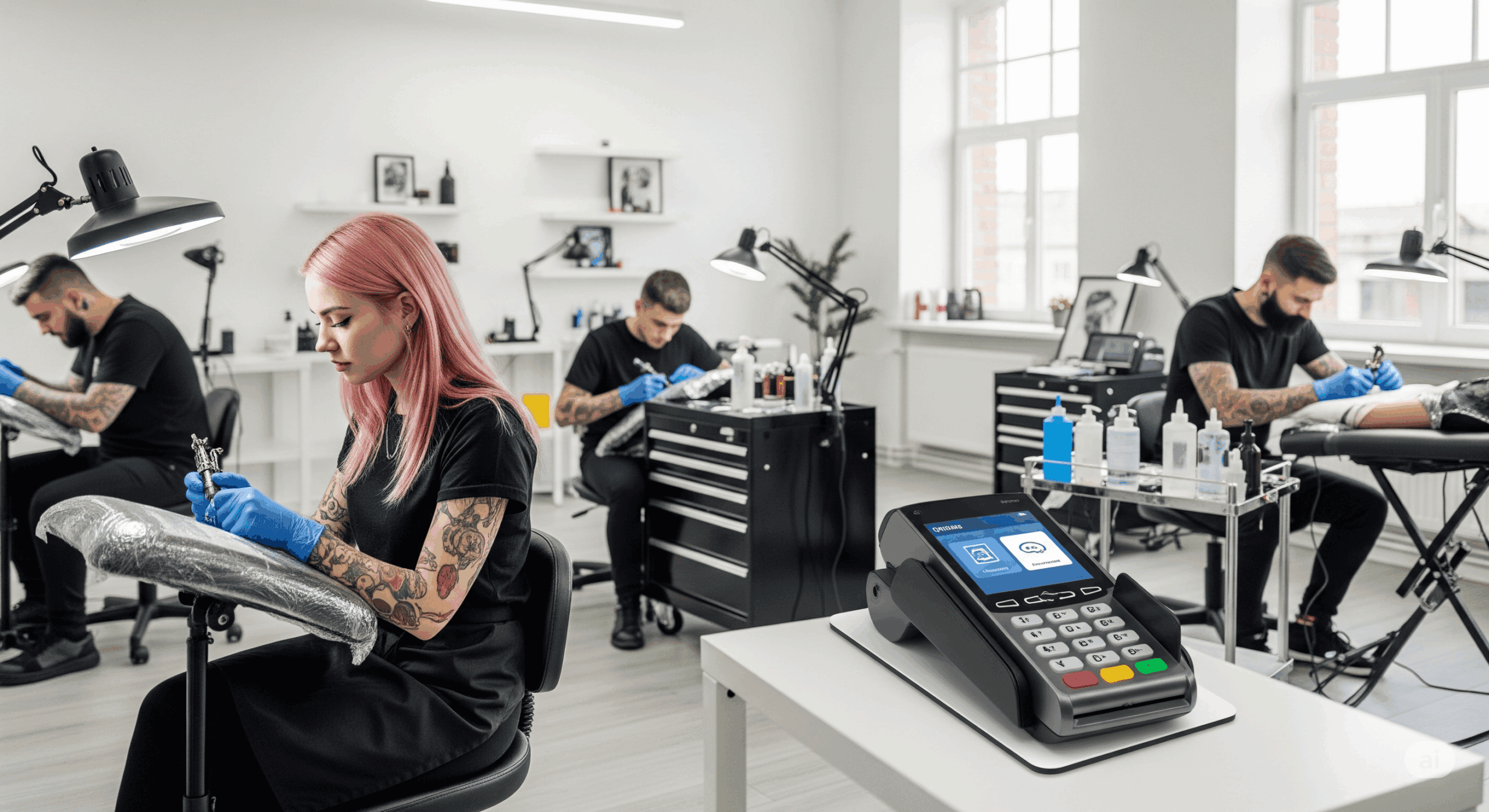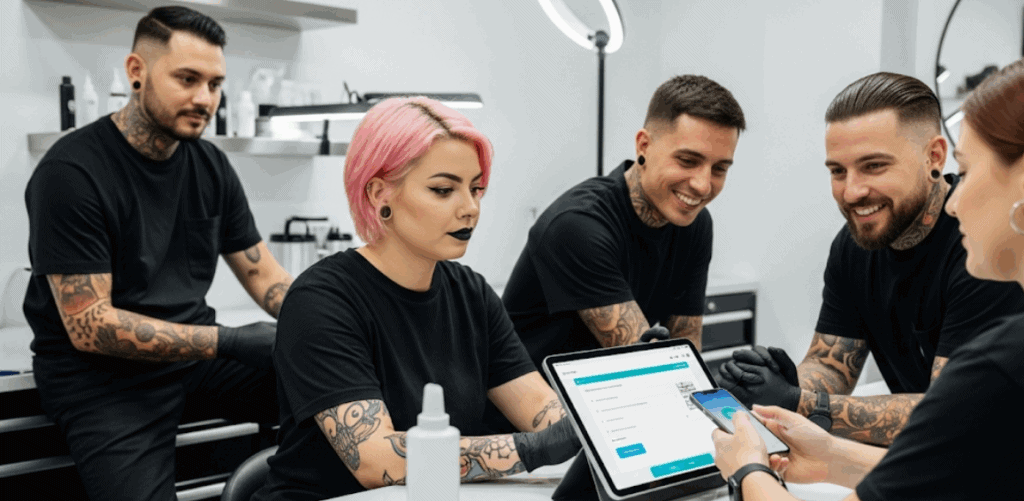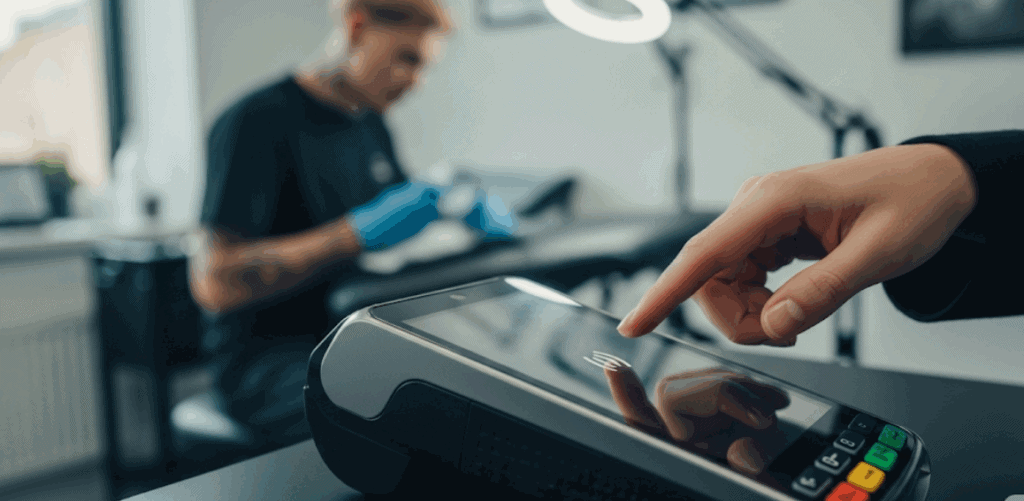
By Terri Humphrey July 24, 2025
In the tattoo studios world, every line matters— whether it’s on the skin, or on the books. Art is personal and intense, but the business behind it can be messy, especially when money is involved. That is why it is necessary to streamline payments.
Having multiple artists on a lineup has its own challenges, including fluctuating artist rates and policies regarding client tips and deposits, as well as commissions. And without an organized, systematic approach, a shop, no matter how skilled its employees, can run into slowdowns at checkout, miscommunication among staff and lost revenue.
Whether you’re running a busy collective, or a burgeoning crew of freelancers all working under the same roof, it’s time to streamline payments. This guide on tools and tactics that can streamline your payment process involves will help your studio grow without the growing pains.
Why Payment Flow Matters in a Multi-Artist Studio?
The way payments are handled in busy tattoo studios can either work well or be painful for both the client and artist. When you streamline payments, you’re not just simplifying transactions — you’re building trust, saving time — and allowing the energy to stay where it should: on the art.

Client Experience
The last things a client wants, after spending hours in the chair is to stand in a line and wait for change. Today’s shoppers demand a quick and easy checkout experience, with features like tap-to-pay and card readers, digital receipts and upfront, transparent pricing. A clunky or awkward payment moment can cast a shadow over an otherwise incredible session. You can offer contactless payment options, digital wallets, QR codes besides debit and credit card options.
Clarity on Artist Payouts and Commission
When the income of artists is not quantified clearly, tension builds. If your tattoo studio is set up on commission, booth rental, or a combination of both, efficient payment processes are a great way to make sure everyone gets paid accurately and on schedule. No more guesswork, no more awkward conversations — just streamline payments and happy artists.

Financial and Tax Reporting
Digital payment histories circumvent the manual nightmare of bookkeeping. When payments are tracked correctly, it’s easier to manage taxes, reconcile tips and issue clear reports for each artist. Hence, for multi-artist tattoo studios proper streamlining and digitizing payment is necessary.
Common Payment Pain Points in Tattoo Studios
When you run a multi-artist tattoo studio there’s a lot to juggle other than ink and appointments. Moreover, your payment process can easily bring you stress if not handled correctly. To streamline payments, you have to understand where they frequently go wrong.
POS or Manual Shared or by Calculation
A lot of tattoo shops have tablets mounted at one front desk counter. This results in long wait times during rushes, and some artists end up having to stop their work just to check people out. With manual tracking of deposits, walk-ins and commission splits, the potential for errors — and conflict — grows. Hence, a modern payment processor is necessary that helps easily to streamline payments.
Tracking Tips & Commissions
There can be confusion around tipping: Is it cash or credit? Does the artist retain the whole amount? Artists may end up feeling shortchanged or uncertain about their earnings, if they’re not tracking them clearly. A trustworthy payment system should make tips transparently distinct, and well-documented, so that every artist knows precisely what they’ve made.

Booking Deposits and No-Shows
Today’s consumers want to book online and pay a deposit at the time of booking. But if your team is still pen and paper or spreadsheet-bound, you’re inviting missed appointments, fights over refunds and uncomfortable conversations. Letting a payment processor do that job for you, and one that supports partial prepayments, can help.
Building a Clear Payment Policy for Multi-Artist Tattoo Studios
If you want to streamline payments of your tattoo studios, it all begins with some clear rules — for clients and artists, alike. When everyone knows what to expect from the outset, there’s less confusion, less room for dispute and fewer headaches in day-to-day operations.
Studio-Wide Payment Rules
Create clear procedures for deposits, no-show fees and refunds. You should prominently display in the store, easy to understand and with email or SMS confirmations issued at the time of making a booking. For instance, if deposits are not refundable or transferable within 24 hours, state that upfront. Transparency safeguards your time and keeps clients to account.
Artist Agreements
Every artist deserves to hear how the money is spent. Is commission purely service based or also includes sales of the product? Who pays for needles, ink or gloves — the studio or the artist? Is the pay out daily in cash or is it a weekly direct transfer? A signed agreement helps to ensure that everyone is on the same page — and that misunderstandings are kept to a minimum.
Tips & Payout Transparency
Clients often assume the tip goes directly to the artist, but that isn’t always the case, particularly with credit card payments. In the first place, ensure all tips are transparently routed. Better yet, use a payment system that allows artists to track their earnings in real time. That visibility builds trust, which is key when you have multiple creatives working under one roof.
Clear policies don’t make your studio feel rigid— they make it smooth and professional, and a place where clients feel respected. Hence, this helps with streamline payments.
Security, Compliance & Receipts
Operating successful tattoo studios isn’t just about art — it’s about taking care of your business and your clients. From protecting your payments to your privacy and yourself from chargebacks, those small steps you take could help you avoid huge headaches down the road.
PCI Compliance for Card Payments
In order to process payments securely, always choose PCI certified devices to make sure that your card reader meets the industry’s security standards. Never store card details yourself, even for regulars. And ensure that any staff or artists who take payments have some basic training on payment safety: no jotting down card numbers, no processing payments over open Wi-Fi, no sharing devices.

Client Privacy
Protecting the privacy of the client is important — it includes their personal and payment information as well. Select a payment system that protects everything with encrypted and secure data. Digital receipts are not just convenient, but also saves you and your customers the paper mess and the potential loss or exposure of details. Hence, this helps streamline payments.
Chargeback Protection
To guard against chargebacks, always issue itemized invoices, capture signatures, and send booking confirmations that clearly outline your deposit and cancellation policy. Taking a photo of completed work (with consent) can also help if questions arise later.
With the right infrastructure, security can be something you don’t think about, not something you have to worry about.
Conclusion
Multi-artist tattoo studios requires freely flowing creative energy — not a tangled-up payment system. When you streamline payments, you’re not only increasing transaction speed; you’re also establishing trust with clients and equity among artists.
Whether that’s creating clear commission rules, providing payment in multiple ways or PayPal/Payoneer/PCI-compliant systems, reducing friction and increasing professionalism in these areas is an ongoing evolution. Digital tools can streamline everything from tips to tax filing, letting artists make art, not account for it.
Smaller upgrades — such as paying out cash in real time or enabling online booking with a deposit — can have a huge impact on morale, revenue and client satisfaction. In the end, an effortless payment experience is a representation of the service you provide.
Tattooing is precision work. Your payment routine must be as sharp.
Frequently Asked Questions
Q1. Can each artist in the studio use their own payment method?
Yes, many payment systems allow artist-specific links or terminals. Just ensure all are PCI-compliant.
Q2. What’s the best way to track tips and commissions?
Use a POS system that automatically splits sales and tips based on preset percentages.
Q3. How can I reduce no-shows for pre-booked sessions?
Take deposits upfront through online booking platforms with clear refund policies.
Q4. Is cash still acceptable in modern studios?
Sure — but offering cards, tap-to-pay, and mobile wallets keeps clients happy and speeds up checkout.
Q5. Do digital receipts protect against chargebacks?
Yes. Digital receipts with itemized services and signatures help resolve disputes quickly and clearly.